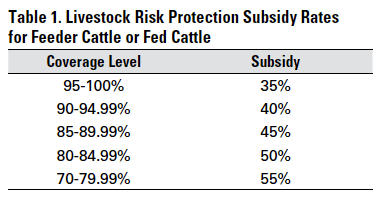Elevate Your Competence with Bagley Risk Management
Elevate Your Competence with Bagley Risk Management
Blog Article
Trick Elements to Think About When Finding Livestock Risk Defense (LRP) Insurance
When examining options for Animals Risk Security (LRP) insurance, numerous essential variables require mindful consideration to make certain efficient threat management in the farming industry. Picking the appropriate protection alternatives tailored to your details livestock operation is extremely important, as is recognizing just how exceptional expenses associate with the degree of security supplied.
Coverage Options
When thinking about Animals Danger Security (LRP) insurance coverage, it is necessary to recognize the numerous protection options offered to alleviate dangers in the farming market. Animals Danger Security (LRP) insurance coverage uses various protection alternatives customized to satisfy the varied requirements of livestock producers.
An additional essential insurance coverage choice is the endorsement period, which establishes the size of time the protection holds. Producers can pick the recommendation period that best matches their manufacturing cycle and market conditions. Additionally, insurance coverage levels and prices differ based on the sort of animals being insured, offering manufacturers the versatility to customize their insurance policy prepares according to their specific needs.
Comprehending the different insurance coverage choices readily available under Livestock Risk Defense (LRP) insurance coverage is important for manufacturers to make enlightened decisions that properly safeguard their animals operations from market unpredictabilities.
Costs Prices

Animals Danger Security (LRP) insurance offers necessary insurance coverage options tailored to alleviate threats in the farming field, with a significant aspect to think about being the computation and framework of premium prices. When determining premium costs for LRP insurance, several elements come into play. These include the type and number of livestock being insured, the protection level selected, the current market value, historical price data, and the length of the insurance coverage duration. Insurers may also consider the area of the ranch, as geographical aspects can affect the general danger profile.
Insurers examine historical data on animals rates and manufacturing costs to figure out an appropriate premium that reflects the degree of threat entailed. It is necessary for animals producers to very carefully review premium costs and protection choices to guarantee they are properly secured versus possible economic losses due to adverse market conditions or unexpected occasions.
Qualified Animals
The determination of qualified animals for Livestock Risk Defense (LRP) insurance policy protection includes cautious factor to consider of certain requirements and attributes. Livestock types that are usually eligible for LRP insurance consist of feeder livestock, fed cattle, lambs, and swine.
Feeder livestock, as an example, are commonly qualified for LRP coverage if they drop within defined weight ranges. Fed livestock may also be qualified, however they must fulfill particular weight and high quality grade requirements. Swine eligible for insurance coverage normally include market weight pets intended for massacre. Lambs are an additional classification of livestock that can be considered for LRP insurance coverage, with elements such as weight and age playing an essential duty in identifying their qualification.
Prior to selecting LRP insurance policy for livestock, producers must carefully examine the qualification requirements laid out by the insurance supplier to guarantee their animals meet the necessary requirements for protection.
Policy Flexibility
Policy flexibility in Animals Risk Defense (LRP) insurance coverage allows producers to customize coverage to match their more tips here certain requirements go to my site and risk monitoring methods. This flexibility encourages livestock manufacturers to personalize their insurance plans based on aspects such as the type of animals they own, market problems, and individual threat tolerance degrees. By providing personalized choices, LRP insurance makes it possible for manufacturers to efficiently handle their risk exposure while guarding their livestock procedures versus unexpected market volatility.
Cases Process
Upon experiencing a loss or damage, manufacturers can launch the insurance claims procedure for their Animals Risk Security (LRP) insurance policy by quickly contacting their insurance policy company. It is critical for producers to report the loss as soon as possible to speed up the cases process. When reaching out to the insurance coverage provider, manufacturers will certainly require to supply comprehensive information concerning the occurrence, consisting of the date, nature of the loss, and any relevant paperwork such as vet records or market prices.

After the evaluation is full, the insurance coverage service provider will certainly make a decision relating to the case and communicate the result to the manufacturer. The manufacturer will certainly receive payment according to the terms of their Animals Risk Security (LRP) insurance coverage policy if the insurance claim is accepted. It is important for manufacturers to be knowledgeable about the claims process to make sure a smooth experience in the event of a loss

Final Thought
To conclude, when choosing Animals Danger Security (LRP) insurance coverage, it is important to take into find out consideration insurance coverage alternatives, premium expenses, qualified livestock, policy flexibility, and the claims procedure. These vital variables will certainly aid make sure that breeders and farmers are effectively secured against potential risks and losses related to their animals procedures. Making a notified decision based upon these factors to consider can eventually result in better financial protection and satisfaction for livestock manufacturers.
Animals Danger Protection (LRP) insurance policy uses different coverage alternatives tailored to meet the varied requirements of livestock manufacturers.The decision of eligible animals for Livestock Threat Security (LRP) insurance protection includes careful factor to consider of particular standards and attributes.Policy flexibility in Animals Risk Defense (LRP) insurance coverage allows manufacturers to tailor protection to match their particular demands and run the risk of management methods.Upon experiencing a loss or damage, producers can launch the insurance claims procedure for their Livestock Threat Defense (LRP) insurance policy by quickly calling their insurance copyright.In final thought, when picking Livestock Danger Defense (LRP) insurance, it is necessary to consider protection alternatives, premium costs, eligible animals, plan flexibility, and the insurance claims procedure.
Report this page